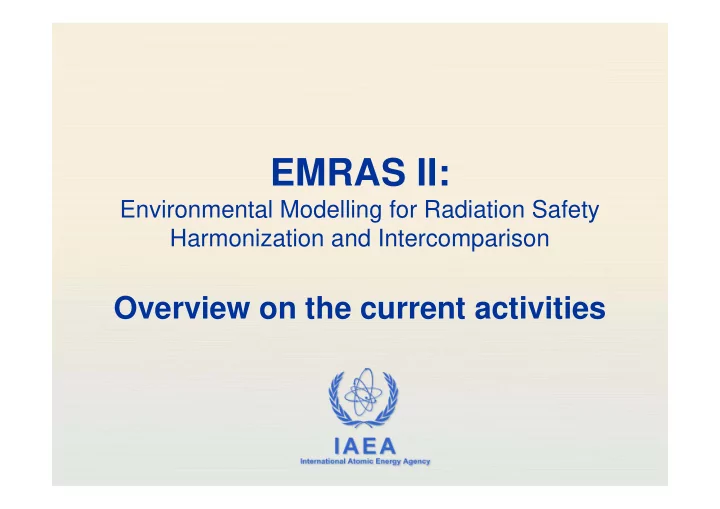

EMRAS II: Environmental Modelling for Radiation Safety Harmonization and Intercomparison Overview on the current activities IAEA International Atomic Energy Agency
General aim of programme To improve capabilities in the field of environmental radiation dose assessment IAEA
Means for achieving improvement - Acquisition of improved data for model testing - Model testing and comparison - Reaching consensus on modelling philosophies, approaches and parameter values - Development of improved methods - Exchange of information IAEA
EMRAS process on Model testing • Test scenario obtained and checked (by data providers) • Modellers invited to make the predictions requested for the scenario (blind testing) • Predictions compared with observations and discussed. • Reasons for mis-prediction identified • Conclusions drawn on how to improve IAEA
Benefits of international model testing • Opportunities to compare with other groups • Wider selection of scenarios for testing • Wider selection of transfer data • Improve modelling capabilities globally IAEA
History of international environmental model testing programmes • 1985–1990 BIOMOVS – Swedish sponsored • 1988–1994 – the IAEA VAMP programme (prompted by Chernobyl) • 1996–2002 - the IAEA BIOMASS programme • 2003–2007 - the IAEA EMRAS I programme • 2009 – new programme IAEA EMRAS II IAEA
EMRAS II • IAEA has recognised the value of EMRAS and the previous programmes and has decided to sponsor another programme in this field • The new programme is linked to: • issues in radiological risk assessment • the needs of countries • new international developments IAEA
EMRAS II topics • Reference Approaches for Human Dose Assessment • Reference Methodologies for "Controlling Discharges" of Routine Releases • Reference Approaches to Modelling for Management and Remediation at "NORM and Legacy Sites" • Reference Models for "Waste Disposal" • Reference Approaches for Biota Dose Assessment • Biota Modelling • “Wildlife Transfer Coefficient" Handbook • Biota "Dose Effects Modelling • Approaches for Assessing Emergency Situations • Tritium Accidents • Environmental Sensitivity • Urban Areas IAEA
Reference Approaches for Human Dose Assessment • Analysis and evaluation of assumptions, models and parameters to control routine to explore possibilities of harmonization • Establishing reference principles and procedures for the prospective assessment of radioactive releases – standard models, parameters, assumptions. • Testing of model predictions based on harmonized principles and procedures • Effects of environmental change on assessment of long-term impact of waste repositories • Extension of the BIOMASS reference biosphere work to consider influence of environmental change IAEA
Reference Approaches for Human Dose Assessment (cont.) Models to assess radiological impact of NORM and legacy sites • Almost all countries have NORM issues • A large demand for modelling the impact • Model improvement and testing for NORM releases • Exploration of reference approaches to NORM release assessment IAEA
Reference Approaches for Biota Dose Assessment • Comparing model results predicting radionuclide concentrations in biota with test data sets • Develop handbook of transfer parameter values for application to biota • Modelling to determine • dose effects on species, • derivation of species protection thresholds, • population effects, acquisition of relevant data IAEA
Approaches for Assessing Emergency Situations • Tritium:– testing in new situations but also • Specific interests in some countries • Transfer of knowledge and training • Environmental sensitivity – • Impact of environment type on radionuclide transfer • Identification of areas where reference approaches are not applicable • Urban • Dispersion and transfer modelling not yet reliable • Currently an important topic IAEA
EMRAS process • Model comparison • Similar to model testing but with hypothetical scenarios • Analysis based entirely on discussion between modellers • Establishing Reference Data Sets • Bring together national experts on transfer data • Review literature • Summarise and recommend default values for use in modelling indicating associated uncertainties IAEA
Recommend
More recommend